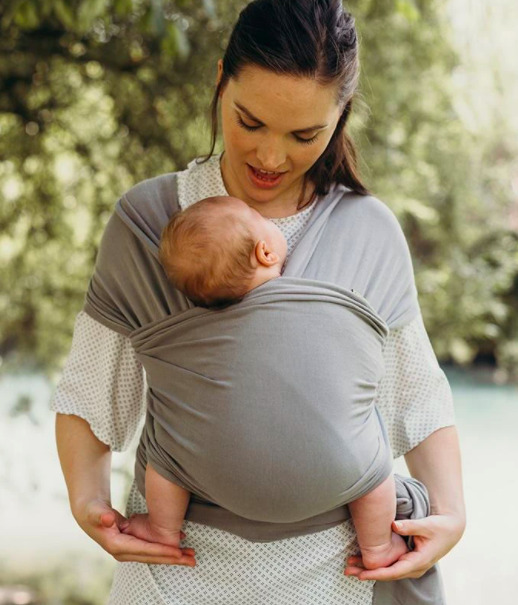As we pulled out of the hospital parking lot with our newborn strapped into his car seat in the back for the first time, I remember thinking, “wow, they trust us with this tiny human!” It’s normal for a new mom to feel nervous, scared, or worried about the initial days home with her new baby. Yes, your mom instincts will kick in, but it’s also helpful to have a few survival strategies on hand. As a mom, NICU nurse, and co-founder of Bright & Baby, where I teach expectant and new parents about their newborns, I’ve learned a lot about how to make your first days at home run smoothly. Read on to see the ways you can survive and thrive during this time.
Tip #1: Do skin-to-skin often
Skin-to-skin is beneficial for both mom and baby. When your baby (wearing only a diaper) is placed directly onto your chest, skin-to-skin helps regulate their heart rate, temperature, and blood sugar. It also promotes mother-infant bonding and helps new parents learn their infant’s early hunger cues. Many think that skin-to-skin is only for immediately following delivery or for preemies in the NICU, but that’s a misnomer—it can be done anytime parents are awake with their newborn. Premature and late preterm babies (babies born at less than 38 weeks gestation) can benefit from doing it as much as you can since these babies require a little help in regulating their temperature and glucose. Pro tip: You don’t necessarily have to hold your baby during skin-to-skin; wraps can make the experience “hands-free.” I loved using the Boba Wrap.

Halo SleepSack is 100% cotton and oh-so-cozy via @halosleep
Tip #2: Practice effective swaddling skills
You may wonder why swaddling is such a big deal. Younger babies have a particular reflex, called the Moro, which causes them to “startle” and wake up with sudden, loud noises. Swaddling their arms helps to decrease their startle response, thus promoting more REM sleep. Swaddling also helps newborns regulate their temperature. When your baby isn’t skin-to-skin or practicing tummy time, swaddle them. I recommend the Halo SleepSack Swaddle because it adjusts three ways to fit your baby’s sleep style and is super soft. Swaddling is only for the first few weeks of life—babies might prefer one or both arms out after that— and stop before your baby learns to roll. For a better idea about this, check in with your doctor for guidance during the first-month well-visit.

My son displaying early to medium hunger cues: turning his head and opening his mouth via @thelizhand
Tip #3: Learn early hunger cues
Feeding your baby before they get hangry is a better and more calming experience all around. It’s essential to learn your baby’s early hunger cues, which will help you know when to feed them. Keeping baby close to you, via skin-to-skin or swaddled nearby, allows you to pick up on the subtle early hunger cues like starting to wake up, opening their mouth, or moving their lips. Medium hunger cues include rooting (turning the head to one side and opening the mouth) and bringing a hand, fist, or fingers to the mouth. Late hunger cues involve crying, screaming, and frantic energy. If your baby is breastfed, attempt to calm them first by gentle rocking, swaying, patting, or skin-to-skin, then proceed with the feeding.
Tip #4: Follow a (somewhat) feeding schedule
How often and how much babies should eat is a question I hear frequently. Breastfed babies are not on a feeding schedule per se and should be offered a feeding 10-12 times per day or more during the newborn period. For bottle-feeding, it’s slightly different: The amount your baby eats from the bottle on the first two days of life is generally small, about 10-15cc, or a quarter of the 2oz ready to feed bottle. Once you bring your baby home, they will most likely eat 1-3oz every 2-4 hours. Babies at this age should not go more than 4 hours in between feedings, even at night. Your pediatrician will chat more about the frequency and volume of feedings at the first well-visit (2-3 days after leaving the hospital).
Tip #5: Monitor the “ins and outs”
You’ll want to have a general sense of what is “going in” and you can do that by monitoring feeding frequency, breastfeeding duration, or volume if bottle-feeding. But you’ll also need to keep an eye on “what is coming out.” This includes the number of wet diapers, the number of diapers with stool, and the stool color. For breastfeeding mamas, one way to know your baby is transferring milk is by diaper count (what goes in is what comes out). You can track this by the old-school pen and paper method. Bright & Baby, which provides virtual classes, support, and resources, has a baby tracker that you can download in their Third Trimester Guide. Or try an app you can download to your phone like Sprout or Baby Tracker. For diaper guidelines, consider this—by the time you arrive home from the hospital, your baby should have several wet diapers a day. By day 6, there should be about 6-8 wet diapers a day and several diapers with stool. A decrease in urine output (i.e., yesterday your baby had eight wet diapers, and today they only had 2) or no wet diapers at all would be a signal to call your baby’s primary care provider.
Tip #6: Know where to find resources
If you know the communication details within your pediatrician’s office ahead of time, it can make a difference when you need an answer. Ask who you should call with a question, like do they have a nurse line, FAQs on their website, or a new parent guide? And with everything going on these days, telehealth communication is crucial. Make sure you are set up with your doctor’s office, and if they don’t offer it, ask what service they recommend. If you’re planning to breastfeed, meet with a lactation consultant prenatally and bookmark resources such as KellyMom or LactMed. Also, be sure to check out newborn care and breastfeeding classes and first mom groups (many have transitioned to virtual) and can be the crucial support team you need—especially during those first few weeks.
NJMOM may receive commissions for purchases made through links in this article.











